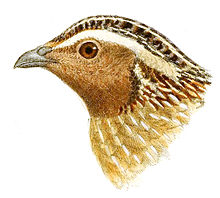Japanese quail
| Japanese quail | ||||||||
|---|---|---|---|---|---|---|---|---|

Japanese quail |
||||||||
| Systematics | ||||||||
|
||||||||
| Scientific name | ||||||||
| Coturnix japonica | ||||||||
| Temminck & Schlegel , 1849 |
The Japanese quail ( Coturnix japonica ) and Japanese quail called, is a bird art from the family of pheasant-like (Phasianidae) used to order the chicken birds heard (Galliformes). It is distributed in East Asia and is similar in habit, behavior and way of life in Central Europe occurring quail .
Because of decreasing populations, the IUCN has classified the Japanese quail as low endangered ( near threatened ) since 2010 .
Appearance
Japanese quails reach a body length of about 20 centimeters and weigh between 90 and 100 grams.
Adult males have an overall gray-brown color with a multitude of red-brown and black strokes. On the middle of the head and on the sides of the crown, the white shaft lines of the feathers form three longitudinal stripes. The throat, front portion of the neck, and cheeks are light brown. In many specimens, a dark brown stripe runs across the middle of the throat, which widens in the lower throat area and merges into a bib. Other individuals only have a small, oval brown spot here. The upper breast is cream-colored with small white vertical lines and merges into a white-gray in the lower breast area, which also extends over the stomach.
The front back shows black horizontal stripes and spots, the white shaft stripes of the feathers result in a longitudinal drawing. The wings are gray. The wing-coverts and wing feathers show a horizontal pattern of thin whitish stripes. The rump and the upper tail are dark with a horizontal drawing of wide black and narrow reddish and white stripes. In some specimens there is a clearly pronounced longitudinal drawing in the form of a light shaft stripe on the tail feathers, with the transverse bands being reduced or even missing entirely.
The females largely resemble the males. The shaft lines on the collar are a little bit sparse and larger. The chest often has a yellowish tinge.
Young birds are colored similar to the females, but their plumage is a little more dull. The downy young are pale yellowish beige on the underside of the body. The top of the body is orange-beige with a dark spot on the forehead. Starting from the forehead patch, two parallel, dark vertical stripes extend to the nape of the neck. A black-brown central stripe runs down the middle of the back to the tail. There are two dark stripes on each wing.
Distribution area and habitat
The distribution area of the Japanese quail extends from northern Mongolia, Transbaikalia and the Amur region in a southerly direction to the central parts of China and in a westerly direction to the basin of the Uws Nuur and Nanchang . It is also found on the Japanese islands, the southern Kuril Islands and Sakhalin .
Unlike the quail, the Japanese quail has a preference for wet meadows, avoiding tall grass. In the Primorye region , the typical habitat of the Japanese quail is humid cotton-grass meadows in groves of Japanese alder with dry elevations and shrub vegetation.
Way of life
As a rule, Japanese quails live singly or in pairs. They feed on the seeds of various perennials and especially grasses. They also eat insects and green plant stems.
Apart from the male's courtship call, which can be heard throughout the summer, no further voices of the Japanese quail are described. Due to the long courtship activity of the males, it is assumed that two annual broods are typical for the species. The nest is on the ground. It usually consists of 10 to 15 eggs.
Japanese quail and human
Japanese quails are kept as poultry. Both the meat and the eggs are consumed. Domesticated Japanese quails now differ significantly from wild Japanese quails. The average weight of the eggs of the domesticated Japanese quail corresponds to 146% of the weight of the wild Japanese quail. Males weigh 140 grams and females 120 and are therefore significantly heavier than the wild form.
supporting documents
literature
- RL Potapov, VE Fling (ed.): Handbook of the birds of the Soviet Union. Volume 4: Galliformes, Gruiformes. Aula Verlag, Wiesbaden 1989, ISBN 3-89104-417-8
Single receipts
- ^ IUCN page on the Japanese quail, accessed May 30, 2013
- ^ Potapov & Fling, 1989, p. 18
- ^ Potapov & Fling, 1989, p. 19
- ↑ Potapov & Fling, 1989, p. 19 and p. 20
- ^ Potapov & Fling, 1989, p. 20

